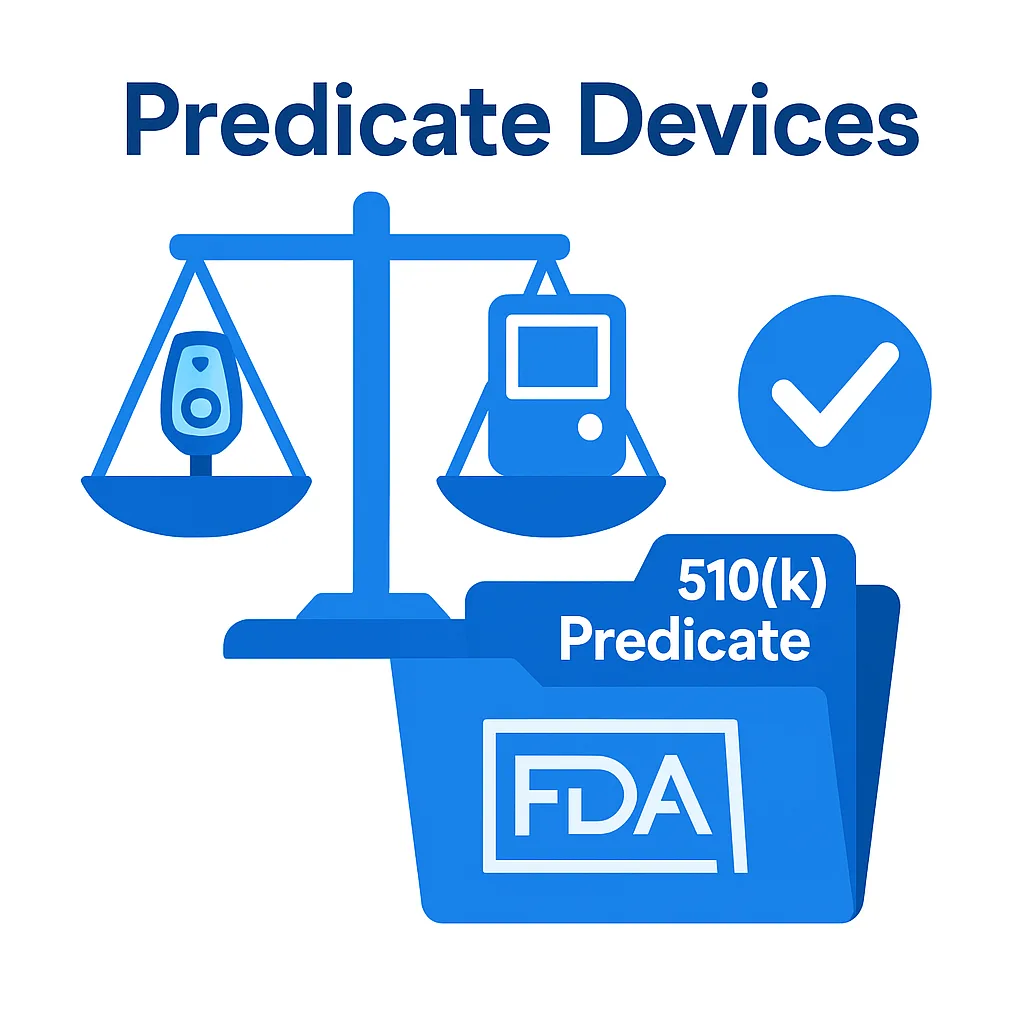Predicate Devices in the 510(k) Pathway: How to Choose Them—and Prove Substantial Equivalence
For most Class II and some Class I medical devices in the USA, FDA clearance hinges on one concept: Substantial Equivalence (SE) to a legally marketed predicate device via the 510(k) pathway. Selecting the right predicate—and documenting why your device is as safe and effective as that predicate—is the backbone of a smooth review. This guide explains what counts as a predicate, how SE is determined, where teams go wrong, and a practical workflow for building a defendable 510(k) around your choice.
- What is a predicate device
- How FDA determines Substantial Equivalence (SE)
- Predicate strategies that work (and those that don’t)
- How to select a predicate (practical workflow)
- Common pitfalls—and how to avoid them
- Submission components that strengthen your SE case
- When a predicate won’t fit—consider De Novo
- Key takeaways
- References (primary FDA sources)
- Schedule a 30-minute consultation
What Is a Predicate Device
A predicate is a legally marketed device (pre-amendments or cleared via 510(k), reclassified, or granted De Novo) that you use to show your device has the same intended use and similar technological characteristics—or, if different technology is used, that it does not raise different questions of safety and effectiveness and you’ve provided data to support that conclusion.
(Section 513(i) of the FD&C Act · FDA Guidance)
FDA’s core 510(k) Program Guidance elaborates on valid predicate types, use of multiple predicates, the role of “reference devices,” and the prohibition on “split predicates.”
How FDA Determines Substantial Equivalence (SE)
FDA reviewers make an SE decision by walking through a structured comparison:
- Intended Use – Is your device intended for the same general use as the predicate?
- Technological Characteristics – Are design, materials, and energy source similar? If different, do those differences raise new or different safety/effectiveness questions?
- Performance Data – Bench, animal (if applicable), and sometimes clinical data demonstrating that performance meets acceptance criteria aligned with risk and recognized standards.
You document the comparison in your submission per 21 CFR 807 (e.g., Indications for Use, device description, performance testing, and optional 510(k) Summary per 807.92).
Predicate Strategies That Work (and Those That Don’t)
Acceptable strategies
- Single predicate covering intended use and key technological features.
- Multiple predicates when no single device covers both intended use and all technological characteristics.
- Reference device(s) strictly to support scientific methodology or performance testing.
Rejected strategies
- Split predicates (separate devices for intended use vs. technology).
- Predicates with different intended use.
- Predicates whose differences raise new safety/effectiveness questions.
How to Select a Predicate (Practical Workflow)
- Define intended and indications for use precisely.
- Search the FDA 510(k) Database and De Novo Database for close matches.
- Screen out mismatches in intended use or technology.
- Align to FDA-recognized consensus standards.
- Assess risk and gaps for any technological differences.
- Confirm documentation readiness using the RTA Checklist.
Common Pitfalls—and How to Avoid Them
- Ambiguous Indications for Use → mirror the predicate’s context and users.
- Outdated predicates → map your testing to current recognized standards.
- Unjustified technological differences → provide clear risk analysis and supporting data.
- Missed modification triggers → use FDA’s “When to Submit a 510(k)” decision flow.
- RTA deficiencies → pre-check all statements, labeling, and formatting before submission.
Submission Components That Strengthen Your SE Case
- Side-by-side comparison table (intended use, users, environment, patient population, materials, energy source, MR safety, EMC, software level, sterilization/packaging, shelf life, biocompatibility endpoints).
- Performance-testing matrix keyed to risk and standards (bench, EMC, biocompatibility, software, usability).
- Labeling comparison noting any differences in indications, contraindications, or warnings.
When a Predicate Won’t Fit—Consider De Novo
If no legally marketed device captures your intended use—or your technological differences raise new safety/effectiveness questions—the De Novo pathway may be the correct route to establish a new Class I or II classification. (Your De Novo, if granted, can then serve as a future predicate.)
Key Takeaways
- Start with a clear, specific intended use—it drives predicate choice.
- Never use a split predicate.
- Anchor evidence to recognized standards and a risk-based test strategy.
- Use RTA pre-screens to avoid delays.
- If SE can’t be supported, pivot early to De Novo.
References (Primary FDA Sources)
- FD&C Act § 513(i) — Substantial Equivalence criteria
- The 510(k) Program: Evaluating Substantial Equivalence in Premarket Notifications
- 21 CFR 807.92 — 510(k) Summary requirements
- Refuse to Accept (RTA) Policy for 510(k)s
- Appropriate Use of Voluntary Consensus Standards in Premarket Submissions
- Deciding When to Submit a 510(k) for a Change to an Existing Device
Schedule a 30-Minute Consultation with Pulse Axis Medical Device Consulting
Navigating predicate selection and demonstrating Substantial Equivalence can define your device’s regulatory success. Pulse Axis Medical Device Consulting helps startups and established manufacturers craft airtight 510(k) strategies, build predicate comparison matrices, and prepare fully compliant submissions.
